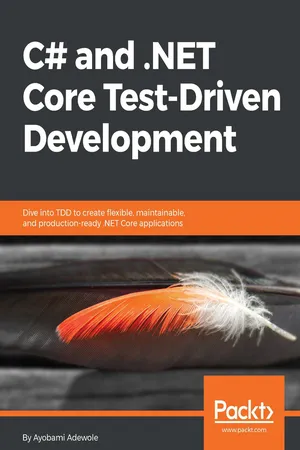
C# and .NET Core Test Driven Development
Dive into TDD to create flexible, maintainable, and production-ready .NET Core applications
- 300 pages
- English
- ePUB (mobile friendly)
- Available on iOS & Android
C# and .NET Core Test Driven Development
Dive into TDD to create flexible, maintainable, and production-ready .NET Core applications
About this book
Learn how to apply a test-driven development process by building ready C# 7 and.NET Core applications.About This Book• Create tests to quickly detect and resolve issues when writing portable code• Uncover code integration issues that improve code quality using continuous integration• Set up and use data-driven unit testing to verify your codeWho This Book Is ForThis book is for.NET developers who would like to build efficient applications by implementing principles of test-driven development. C# programming and working knowledge of VS is assumed.What You Will Learn• Write flexible, maintainable, and verifiable code for.NET Core• Write testable code using SOLID principles and dependency injections• Recognize the characteristics of a good unit test• Structure and group your unit test• Use mock objects to handle dependencies• Set up an end-to-end continuous integration processIn DetailThis book guides developers to create robust, production-ready C# 7 and.NET Core applications through the practice of test-driven development process.In C# and.NET Core Test-Driven Development, you will learn the different stages of the TDD life cycle, basics of TDD, best practices, and anti-patterns. It will teach you how to create an ASP.NET Core MVC sample application, write testable code with SOLID principles and set up a dependency injection for your sample application. Next, you will learn the xUnit testing framework and learn how to use its attributes and assertions. You'll see how to create data-driven unit tests and mock dependencies in your code. You will understand the difference between running and debugging your tests on.NET Core on LINUX versus Windows and Visual Studio. As you move forward, you will be able to create a healthy continuous integration process for your sample application using GitHub, TeamCity, Cake, and Microsoft VSTS.By the end of this book, you will have learned how to write clean and robust code through the effective practice of TDD, set up CI build steps to test and build applications as well as how to package application for deployment on NuGet.Style and approachThe book explores the concepts of test driven development in depth so readers can apply these proven techniques to build sophisticated software with C# and.NET.
Frequently asked questions
- Essential is ideal for learners and professionals who enjoy exploring a wide range of subjects. Access the Essential Library with 800,000+ trusted titles and best-sellers across business, personal growth, and the humanities. Includes unlimited reading time and Standard Read Aloud voice.
- Complete: Perfect for advanced learners and researchers needing full, unrestricted access. Unlock 1.4M+ books across hundreds of subjects, including academic and specialized titles. The Complete Plan also includes advanced features like Premium Read Aloud and Research Assistant.
Please note we cannot support devices running on iOS 13 and Android 7 or earlier. Learn more about using the app.
Information
.NET Core Unit Testing
- The attributes of a good unit test
- The current unit testing framework ecosystem for .NET Core and C#
- Unit testing considerations for ASP.NET MVC Core
- Structuring unit tests with xUnit
- Proving unit test results with xUnit assertions
- The test runners available on both .NET Core and Windows
The attributes of a good unit test
Readable
[Fact]
public void Test_CheckPasswordLength_ShouldReturnTrue() {
string password = "civic";
bool isValid=false;
if(password.Length >=10)
isValid=true;
Assert.True(isValid);
}
[Fact]
public void Test_CompareTwoStrings_ShouldReturnTrue() {
string input = "civic";
string reversed = new string(input.Reverse().ToArray());
Assert.Equal(reversed, input);
}
Unit independence
[Fact]
public void Test_DeleteLoan_ShouldReturnNull() {
loanRepository.ArchiveLoan(12);
loanRepository.DeleteLoan(12);
var loan=loanRepository.GetById(12);
Assert.Null(loan);
}
Repeatable...
Table of contents
- Title Page
- Copyright and Credits
- Dedication
- Packt Upsell
- Contributors
- Preface
- Exploring Test-Driven Development
- Getting Started with .NET Core
- Writing Testable Code
- .NET Core Unit Testing
- Data-Driven Unit Tests
- Mocking Dependencies
- Continuous Integration and Project Hosting
- Creating Continuous Integration Build Processes
- Testing and Packaging the Application
- Other Books You May Enjoy